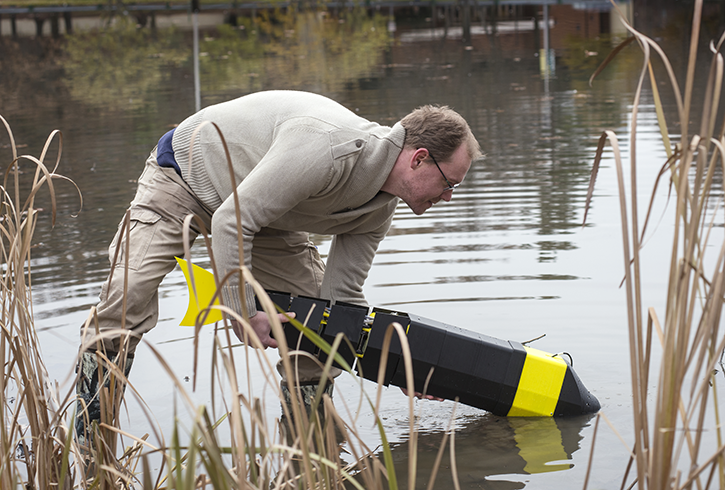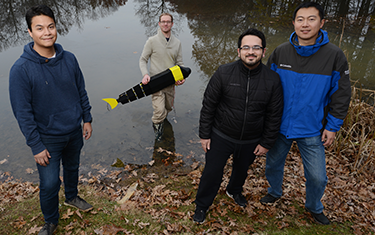
Computer engineering student Blazej Horyza and two other seniors created this robotic fish, which is about four feet long and weighs 17 pounds, for their senior design project. Eventually, marine biologists and environmentalists will use robotic fish to track aquatic life and monitor the conditions of the ocean, rivers, and lakes. Photo by Evan Cantwell
“It’s about four feet long and weighs 17 pounds and performs as we wanted it to perform.”
— Computer engineering senior Blazej Horyza

Computer engineering seniors designed and built this robotic fish so that a user can send commands to the buoy through a private wireless network on a laptop, tablet, or smartphone. Pictured from left to right: seniors Sergio Cruz, Blazej Horyza, and Morteza Eskandari with Feitian Zhang, assistant professor in the Department of Electrical and Computer Engineering. Photo by Evan Cantwell
It swims like a fish, turns like a fish, and dives like a fish, but it’s not a fish. It’s a robot.
Three Mason Engineering seniors have created a robotic fish that can navigate water through wireless commands.
“We designed and built the robotic fish from scratch,” says Blazej Horyza, one of the computer engineering team members on the capstone design project. “It’s about four feet long and weighs 17 pounds and performs as we wanted it to perform.”
“We can talk to the robotic fish and tell it what to do—swim forward, speed up, turn left, and turn right,” says faculty supervisor Feitian Zhang, assistant professor in the Department of Electrical and Computer Engineering.
Eventually, marine biologists and environmentalists will use robotic fish to track aquatic life and monitor the conditions of the ocean, rivers, and lakes. “If there is a disastrous event such as an oil spill, we can deploy the robotic fish to investigate,” Zhang says.
The yellow-and-black robot that the team, which includes Sergio Cruz and Morteza Eskandari, calls Bumblebee or Goldilocks, has:
- Three battery-powered electric motors to generate tail movement.
- An onboard computer, magnetometer (compass), water pressure sensor, video camera, and an accelerometer.
- A buoy on top with a wireless antenna inside.
The user sends commands to the buoy through a private wireless network on a laptop, tablet, or smartphone. Those directions are transmitted to the fish’s onboard computer via a tethered cable.
Horyza says the project had its challenges, such as programming the private network and waterproofing the body of the fish. “Every time we tested it, something new came up. It was daunting at times but also interesting.”
The total cost of the project was under $600.
In the next few years, Zhang plans to work with other students to build on this concept, with the goal of creating a school of robotic fish.
Robotic fish will be equipped with sensors that can collect data on temperature, algae, dissolved oxygen content, and oil, he says. “We will have real-time feedback and information about water quality.”
“We can talk to the robotic fish and tell it what to do—swim forward, speed up, turn left, and turn right.”
— Feitian Zhang, assistant professor in the Department of Electrical and Computer Engineering
